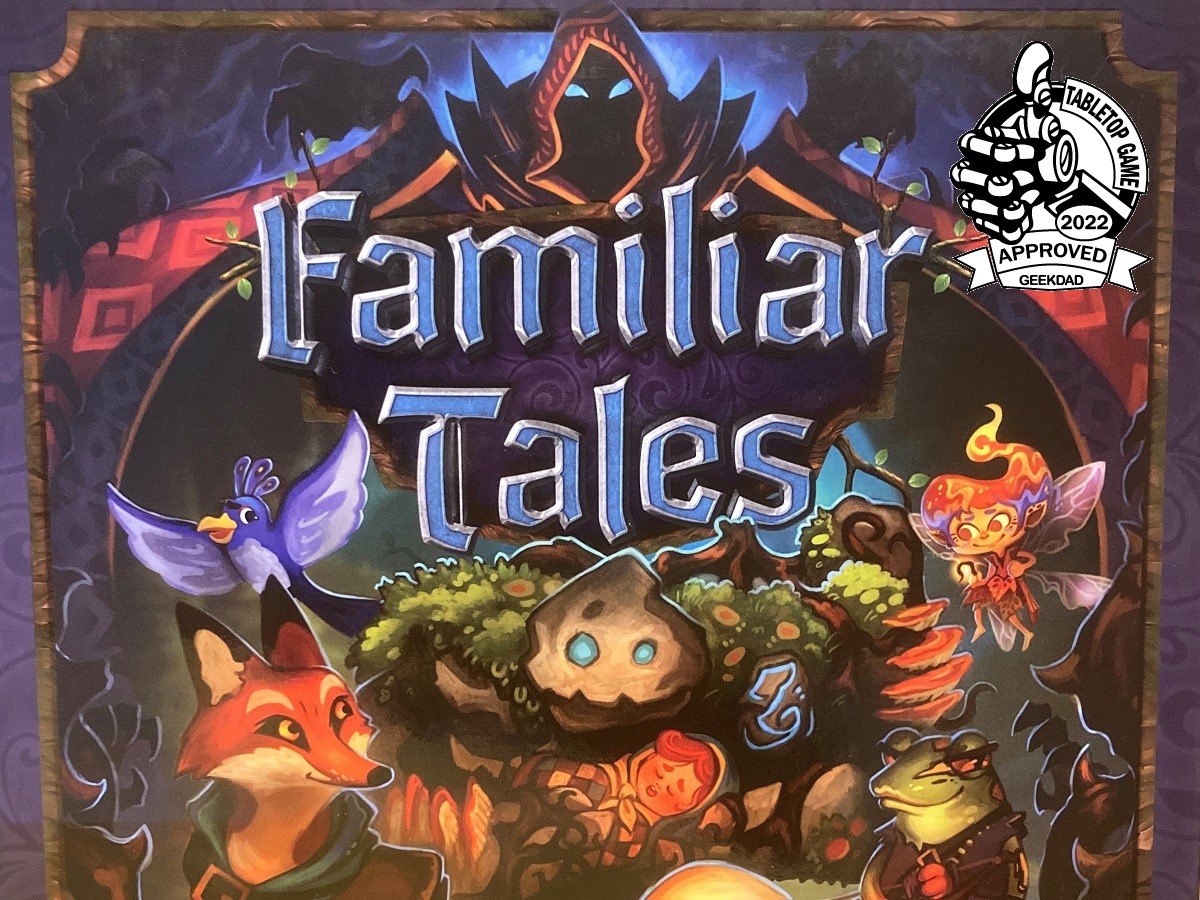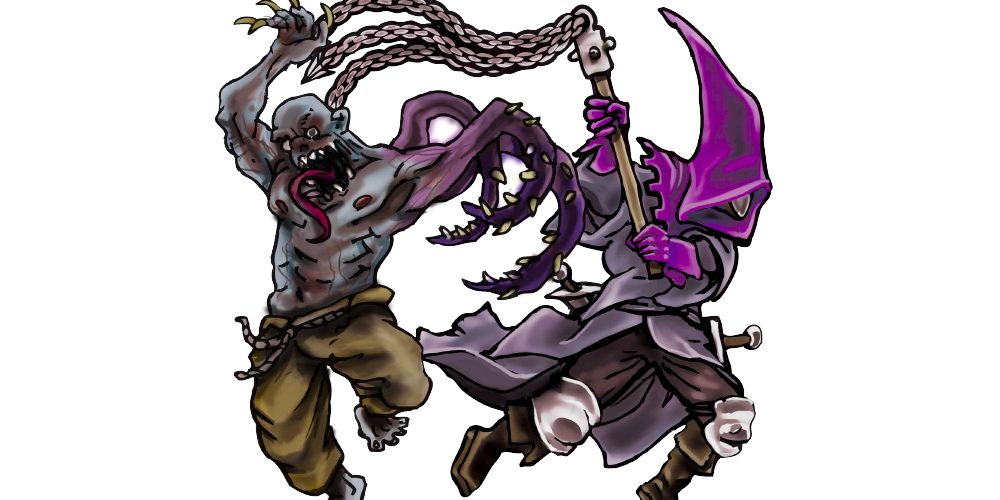Dark forces have displaced the royal family in the far off kingdom of Principalia. The royals have all disappeared save for one, a wee infant. On a dark night, a mysterious woman delivers the babe to the home of a wizard for safekeeping. However, not even a wizard’s residence is enough the keep the little one safe. The wizard sends his four beloved familiars to take and keep the baby safe. Can you help protect the child as she grows up and fulfills her destiny?
What Is Familiar Tales?
Familiar Tales is a story crafting game for 1-4 players, ages 8 and up, and takes about 30-45 minutes on average to play a location. Players take on the roles of one or more familiars as they move through a series of stories while fighting enemies, gathering resources, and gaining new skills and equipment as they progress. The game requires a free app which not only tells the story as you progress, but keeps track of turns during the game as well as your progress through the campaign. Familiar Tales is currently available from your FLGS as well as online retailers such as Amazon for a suggested retail price of $79.95 for a copy of the game, though some retailers such as Amazon have it for around $64. Familiar Tales was designed by Jerry Hawthorne and published by Plaid Hat Games, with illustrations by Vanessa Morales, Tregis, JJ Ariosa, Fajareka Setiawan, and Dan Smith.
Familiar Tales Components
Here is what you get in the box:
- 1 Location book
- 1 Side board
- 1 Die
- 1 Campaign journal pad
- 7 Deckboxes
- 26 Plastic figures
- 4 Familiar character cards
- 4 Familiar dashboards
- 108 Standard cards
- 52 Mini cards
- 90 Tokens and markers

The maps for each location in the campaign are all contained in the location book. When instructed by the app, you turn to the page with the correct location. On the left page of the two-page spread you find the map while the specific instructions for setup, play, and victory are all found on the right page. There are even health tracks for enemies on the pages.
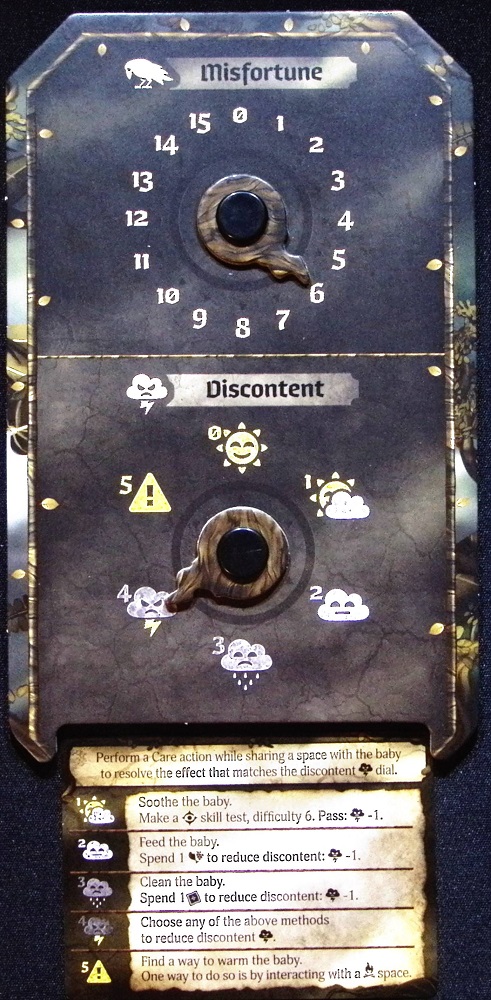
The side board contains two dials and is placed to the side of the location book during play. The dials keep track of misfortune as well as discontent.

The campaign is divided into three eras, each with their own page of the journal. Each era consists of three chapters. During the campaign, the journal sheets help keep track of your progress and lets you know which codes to enter into the app for directions on which location to play next.
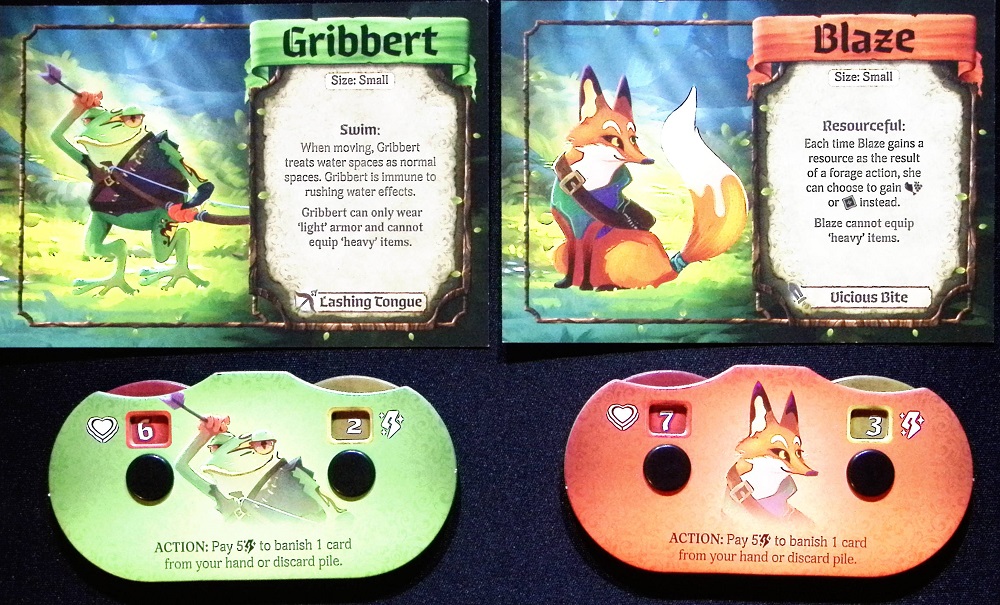
Each of the four familiars has their own dashboard which keeps track of the characters life and power values. There are also cards for the familiars which have their backstory as well as their special ability and starting weapon listed.
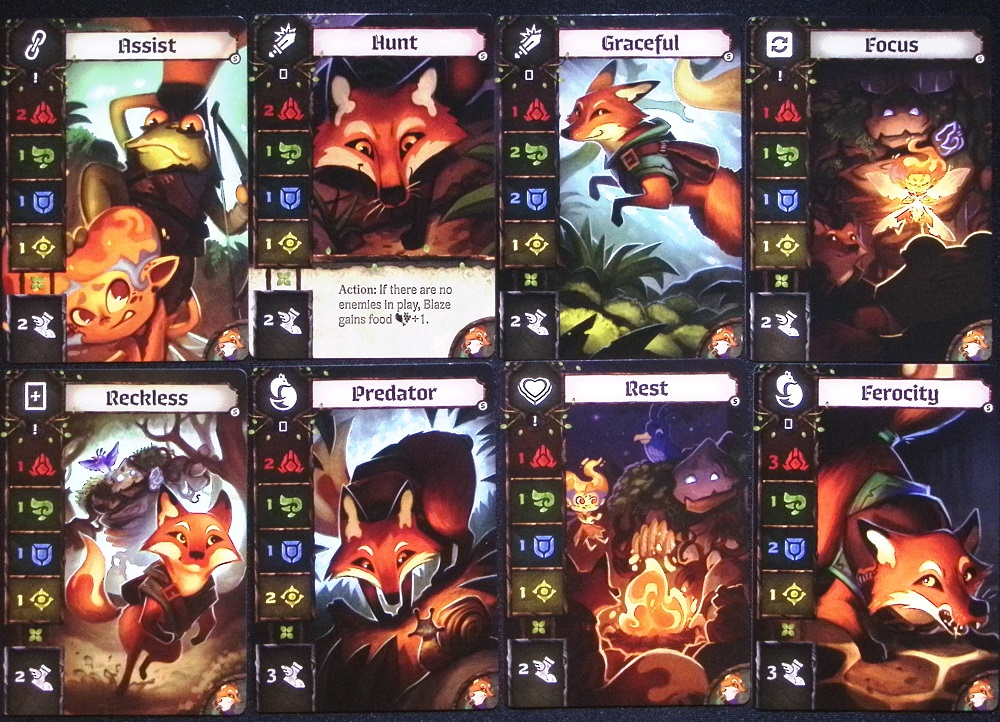
Skill cards are played when making skill tests, moving across a map, and for taking certain actions. Along the left side of each card, starting at the top is an icon effect, which can affect some weapons or abilities, values for the four skills (might, agility, resilience, and insight), and a move point value. Some may also list a special action you can take with the card.

The smaller cards are used for items which also include weapons. Some items are available to purchase while others are obtained as artifacts which you can find during the campaign.
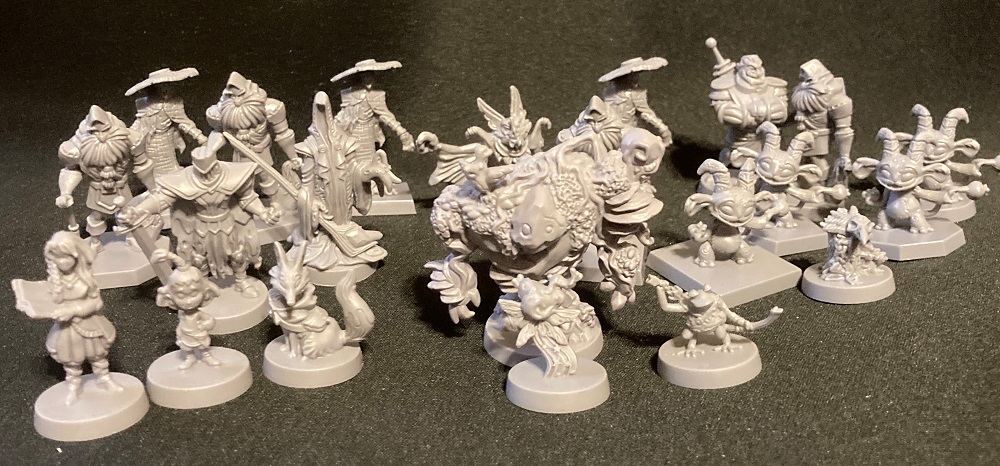
There are figures for each of the four familiars as well as the child and the enemies you will encounter during the campaign.
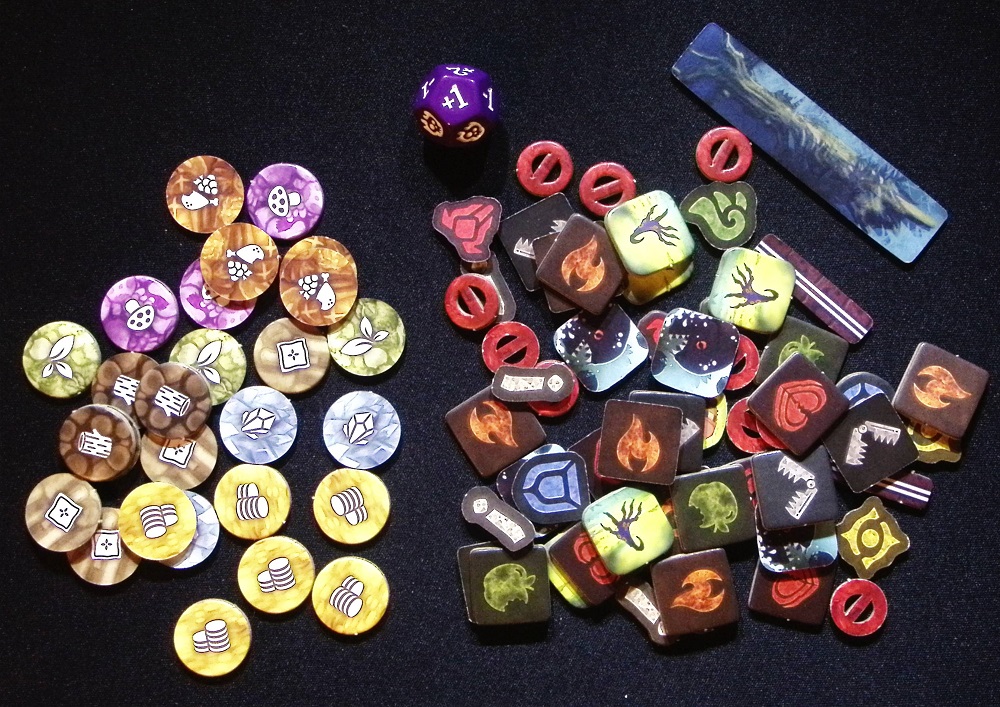
There are lots of tokens used to represent resources you can collect as well as markers so show devotion or afflictions as well as tokens related to rules specific for certain locations.
How to Play Familiar Tales
You can download a copy of the rulebook here.
The Goal
The goal of the game is to complete each of the chapters within the story while gaining as little misfortune as possible. The level of success determines how the story ends.
Setup
When starting a campaign, each player determines which familiars they will play. All four familiars are required, so if there are fewer than four players, some players will control more than one familiar. Players then take their familiar dashboard and card as well as the deckbox with all of their starting skill cards and item cards. Log onto the online app and it literally walks you through the entire setup process. If you are continuing a campaign, your dashboards should have the same values as they did when you completed the most recent location and any new skill or items cards you have collected will now be in your deckboxes. The app will direct you which page to turn to in the location book and require you to enter in the turn order of the four familiars as the players decided among themselves.
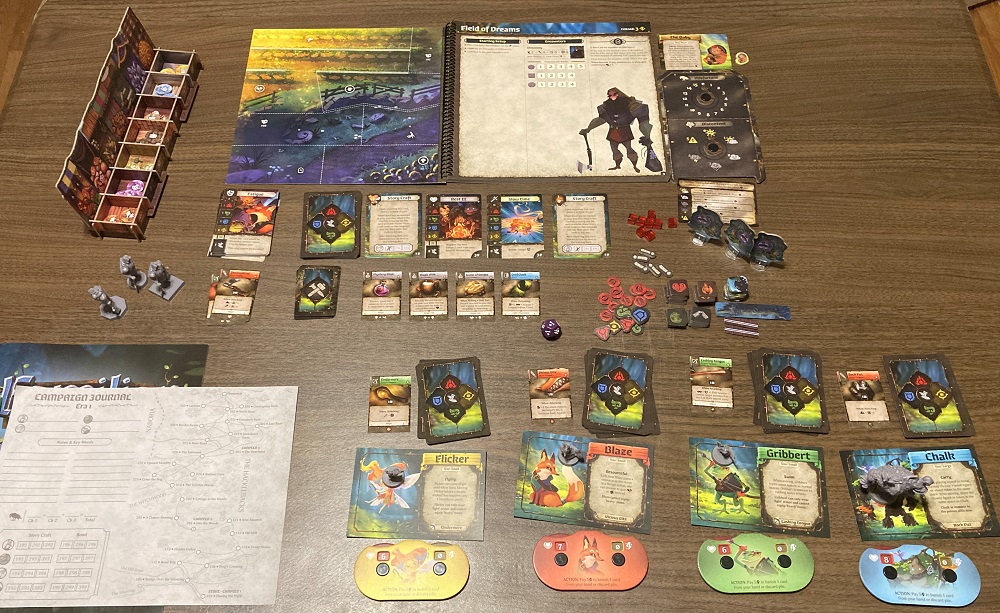
Gameplay
The Familiar Tales app really runs the game, allowing players to focus on the story and playing the game. The game is played in a series of turns for each of the four familiars. The app keeps track of which familiar’s turn it is. However, enemies will get turns unexpectedly, so you never know when it will occur. As the danger level increases, caused by actions and skill cards played, the frequency of enemy turns increases. It is important to note that when playing with less than 4 players, some players will control more than one familiar. In those cases, the players conduct separate turns for each familiar they control.
Playing a Turn as a Familiar
A familiar’s turn is divided into two phases: the action phase which is then followed by the draw phase. During the action phase, a familiar can perform a variety of actions. Some are dependent on the space on which they are located on the map. Players can perform as many actions as they desire so long as they have the skill cards necessary to pay for the actions. Let’s take a look at each action in turn. A player can move their familiar by playing a skill card with a movement point value. They can then spend those points to move from space to space on the map, spending a movement point for each dashed line they cross.
Some special abilities or conditions for the location can modify movement costs. If the space a familiar occupies contains an uncovered resource symbol, they may perform a forage action. This requires a skill test (explained later) and if the test is passed, then the familiar collects a matching token of the resource. Since you are watching over a child, there is the care action. This is used to lower the child’s level of discontent.
The key card which is positioned below the discontent dial lets you know what you must do for the action. For example, you may need to perform a skill test or spend a resource. The equip action lets you equip or move items to your stash. You can have one weapon, one armor, and one accessory equipped at a time. Their bonuses are only active when equipped. The equip action does not cost any resources or require the play of skill cards, so it is essentially a free action.
The trade action allows you to exchange items and resources with another familiar who is located in the same space. The cost of this action is to increase the danger level by one. You can gain new items using the craft action. to do this, select an item from the crafting row of cards and pay the cost of the item in resources. Then you can equip the item or add it to your stash. You can gain new skill cards from the training row by performing the train action. This costs power which is taken from the power level on your familiar’s dashboard. There are two types of attack actions: melee and ranged. Since they are more involved than other actions, they will be discussed in greater detail a bit later. There are also special actions you can take which are listed on skill cards, the familiar’s dashboard or card, or related to a space in the current location. These may or may not have costs associated with them. Once you have completed all the actions you want to perform, then move to the draw phase and draw cards so you hand has a total of five.
Skill Tests
Skill tests are an important part of gameplay. Certain actions require you to perform a skill test based on one of the four skills mentioned earlier. There is usually a value you are trying to match or exceed with your test. To perform a skill test, you play one more more skill cards and add up the number next to the required skill on each card. For example, if you were making an agility skill check, you would only add the agility numbers on each played card. Many skill cards have an icon in the top left corner which can provide additional benefits or add to the danger level. Be sure to use those that apply. Once you have tallied up your skill total, then roll the chance die and add positive numbers or subtract negative numbers from your total to determine the final value. If it is equal to or greater than the skill requirement, you pass the test. Failing the test has no negative effects. Once the skill test is completed, discard all of the skills cards used.
Combat
There are two types of combat, melee attacks and ranged attacks. To perform a melee attack, a familiar must be in the same space as an enemy. You then do a might skill check based on the enemy’s defense value. If you succeed, then you inflict the damage listed on the equipped weapon along with any additional damage gained by card or item powers. If an enemy’s life is reduced to zero, it is removed from the map and the familiar that defeated it gains any loot the enemy has. Ranged attacks require the target to be in the familiar’s line of sight. This is determined by tracing a line from the dot in the center of the space the familiar is in to the dot in the space where the enemy is positioned. As long as the line of sight does not cross a double solid line on the map, the attack may take place. There are some weapons that have a limited range, so you need to make sure the familiar is within that range. A ranged attack is resolved in the same manner as a melee attack except you do an agility skill test.
Enemy Turns
The app will let you know when the enemy gets a turn and what they do. Enemies have movement and attack values listed in the location book. They can move up to their movement value and then attack as directed by the app. When a familiar is attacked, it may defend. To do this, make a resilience skill test by playing skill cards and rolling the chance die. The difficulty of the test is the attack value of the enemy. If the familiar passes the skill test, then it receives no damage. However, if it fails the damage received is the difference between the attack value and the result of the skill test. A familiar who chooses not to defend does not perform a skill test but instead receives damage equal to the attack value. If a familiar’s life reaches zero, it is defeated and flees. Remove its figure from the map and place it on its character card. Increase the misfortune level by 2 and add 2 fatigue cards to the familiar’s discard pile. Set the familiar’s life dial to its maximum value and place a badly injured affliction token on the character card. On that familiar’s next turn, you can return it to the map on any space containing another familiar. Place it on a flag or campfire space if no other familiars are in play.
Game End
The game ends when you reach the end of a chapter. The app guides you through how to save your game and prepare for the next chapter. After you complete chapters 3 and 6, you have completed an era and will need to perform some additional steps as provided by the app. You can also end play once you have completed a location. The app will guide you on how to put the pieces away to save your current status for the next game.

Familiar Tales is a 2022 GeekDad Game of the Year Finalist!
Why You Should Play Familiar Tales
When I first heard about Familiar Tales, I was intrigued and could not wait to get my hands on a copy. I was not disappointed. I enjoy games that have a story or at least revolve around a theme. In Familiar Tales, the story is the game that the players create as they play. As a result, it is very easy for players to become engaged in the game. Along with illustrations reminiscent of an animated fantasy movie, and the location book which takes players further into the story with each turn of the page, Familiar Tales has a lot going for it.
The location book offers a great way to keep the game interesting without players having to pull out the game manual all the time. When you play a location, the location book is your gameboard. You place the figures on the book and move them around from space to space. I like how special rules are printed right on the pages for the current location and how the health meters for the enemies are on the pages as well. No need to look them up or use enemy cards for keeping track of their health and attack/defense values. Plus some spaces have a number which you can enter into the app for more information or to drive the story further. I really like games that use location or story books to provide a lot of variety to gameplay while making it simple for the players.
Onto the topic of the app, let me begin by stating that it is very impressive. Plaid Hat Games has used apps to help drive the story and gameplay of previous games such as Abomination: The Heir of Frankenstein and Forgotten Waters, both games which I enjoy. However the app for Familiar Tales takes it to the next level. For those just learning the game, the app features a tutorial that walks you through an entire game. It helps you set up the game and then guides you through each player’s turn. I really like the details in the tutorial. For example when making a skill check, it asks about icons on the cards and if any of them apply to your familiar or the items they are carrying. I found this useful since there are some intricacies to skill checks that are easy to forget as one is learning to play. Not only does the app help teach the game, it also keeps track of whose turn it is and controls when enemies get their turns and what they will do on those turns. Finally, the app contains the entire story of the game with dramatic readings by voice actors, sound effects, and background music. I really like how the app immerses the players in the story.
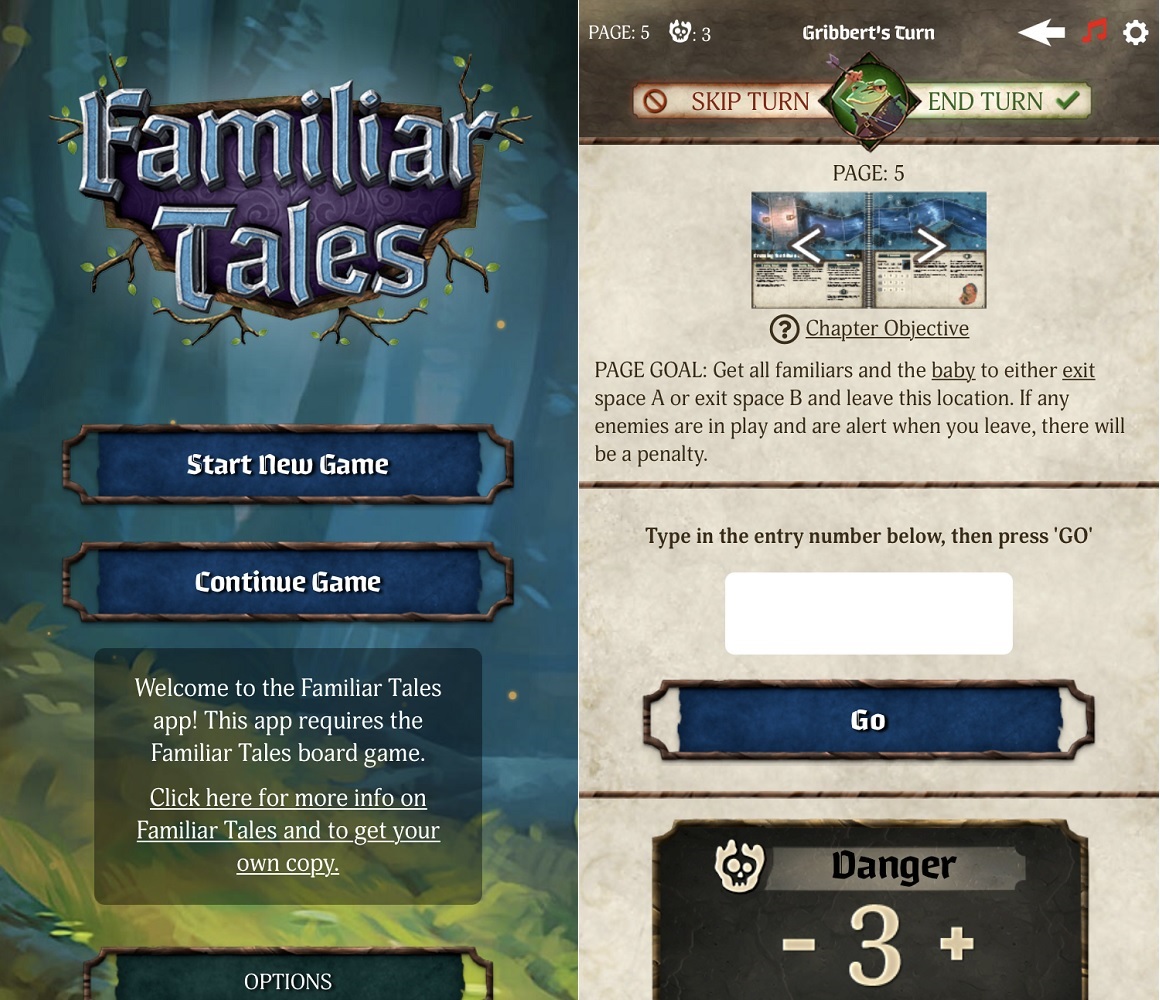
The game mechanics are another aspect of Familiar Tales which I really like. During a familiar’s turn, there are lots of different actions from which to choose. Most of them require the use of skill cards which act as a form of action points. They contain values for movement and each of the four types of skills as well as bonus icons. Some even have special actions for which they can be used to perform. Each skill card has various values on them. For example, the Rest card has skill levels of only 1, but when you play it, you heal up one life level. Others may have high movement or high levels in one or two skills. Plus during a game, you can spend power to ‘train’ which entails gaining new skill cards to add to your deck. These all provide some flexibility for players. If you need to do a lot of moving, you can spend several of the cards from your hand just to move. That of course means you have fewer cards remaining for skill tests. On the other hand, when attacking an enemy, you will most likely spend several cards to ensure the success of your skill check so you can inflict damage. Plus, if a card has a chain symbol in the top left corner, such as Assist, you can actually play this card during another familiar’s turn to apply is values to their skill check and help them pass it. Skill checks are not only used for combat, but for foraging and other actions. Since the chance die can add to or subtract from your total value from your played skill cards, there is an element of luck. If I really want to pass a skill check, I usually play cards so I have 2 skill points over what is required since that -2 tends to come up during a roll when you really need to succeed. Since you always draw up to five cards for your hand at the end of your turn, there is not much reason to save cards unless there are some you will need for your next turn. Plus, when attacked by the enemy, you will have a full hand of cards to help you defend. Unfortunately, you don’t draw more cards until the end of your next turn, so whatever you spend to avoid a damage will limit your ability to take actions during your turn. This too adds to the strategy of the game. Do you want to avoid damage, or save up your cards for a powerful counterattack on your turn. The way the game uses skill cards provides a unique way for players to choose what they want to accomplish during their turn and this game mechanic works great.
When you are reading a book, you can always put in a bookmark to save your place in the story and come back to it later. Familiar Tales offers the same freedom. Once you complete a location, which can take only 30 minutes, the app gives you an option to either continue playing or to save your place for another gaming session. If you choose to quit for the time, the app walks you through how to put the game away so it is all ready to play next time you open the box. The deckboxes are perfect for this. Each familiar has their own deckbox where they can store all of their skill cards, items, and resources. Just leave the dashboard dials and the sideboard dials set as they were at the end of the game and you can then continue from where you left off next time. The app will even save your progress. This feature really helps bring Familiar Tales to the table more often and is great for playing with younger children. You can play just one or two locations in the evening and then continue the next night. Plus once you have played a few times, setup and cleanup go fairly quickly.
In conclusion, I really love playing Familiar Tales. It has so many great things going for it. It looks great, is easy to learn, provides some interesting and unique game mechanics, immerses the players in an engaging story which they create as they play, and offers flexibility on how much players want to play at one sitting. My family really enjoys this game, whether we play one location or more at a time, as we work work together to take care of the child and keep her safe. It is for these many reasons that Familiar Tales is GeekDad Approved and I highly recommend this game for families as well as gaming groups who enjoy a good story and great gameplay.
For more information, visit the Familiar Tales webpage!
Note: As an Amazon affiliate, I may earn a small commission on qualified purchases.
Click here to see all our tabletop game reviews.
![]() To subscribe to GeekDad’s tabletop gaming coverage, please copy this link and add it to your RSS reader.
To subscribe to GeekDad’s tabletop gaming coverage, please copy this link and add it to your RSS reader.
Disclosure: GeekDad received a copy of this game for review purposes.
